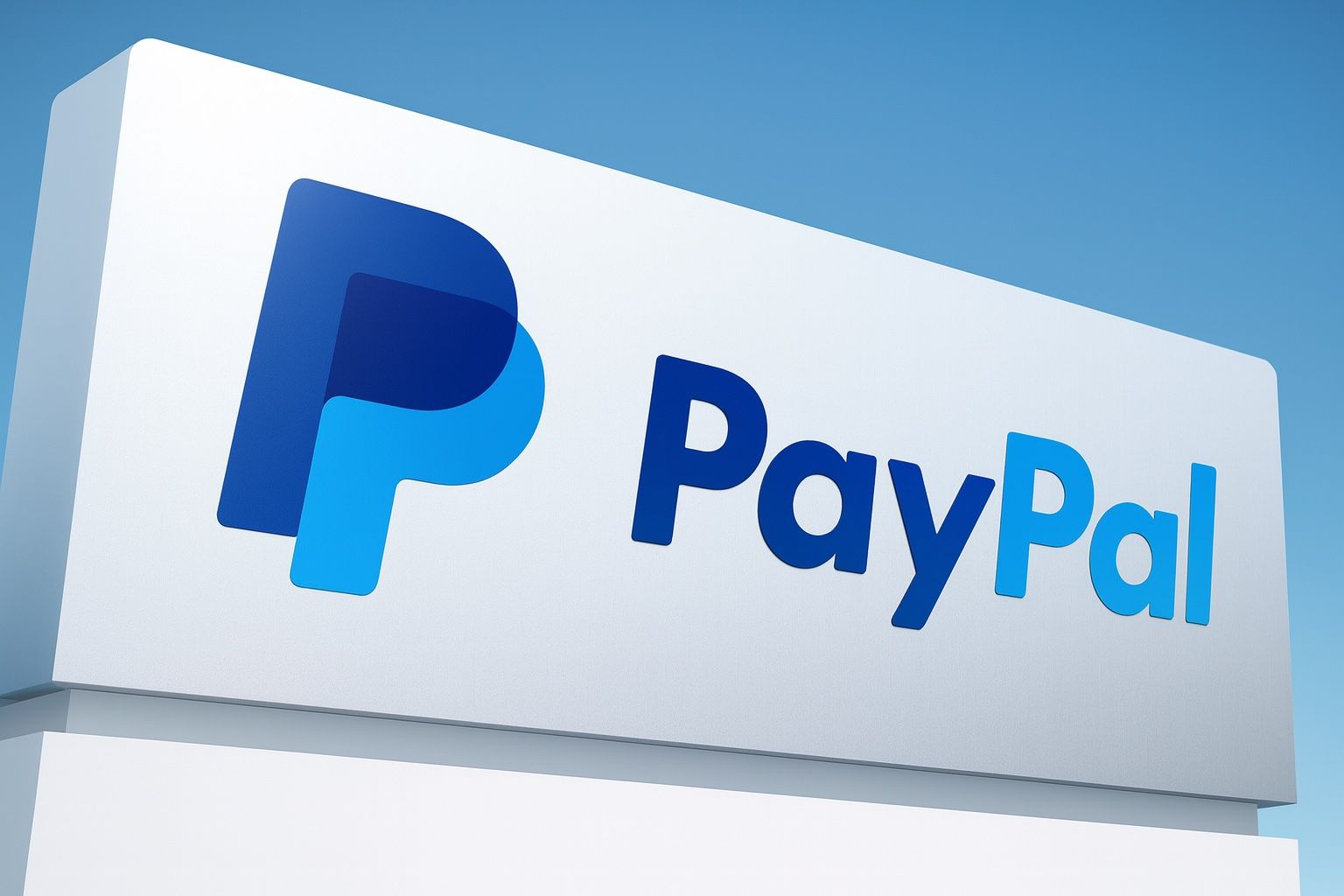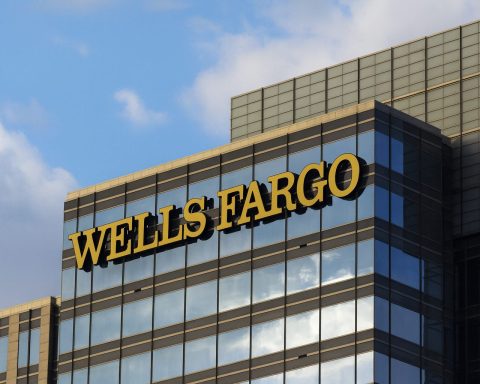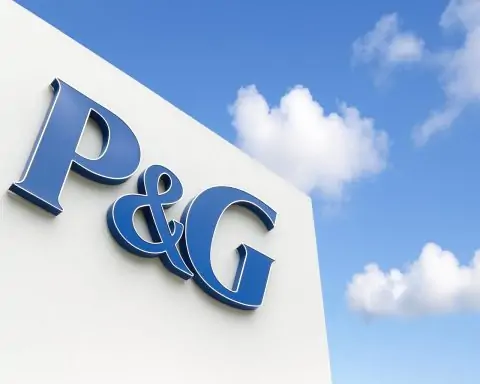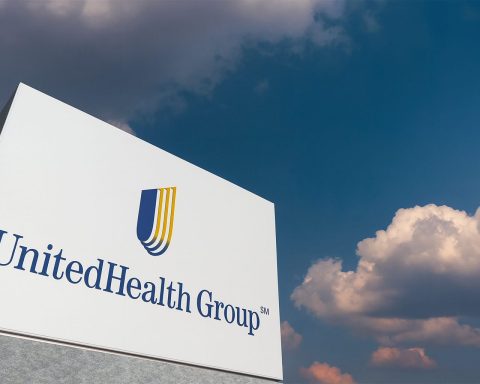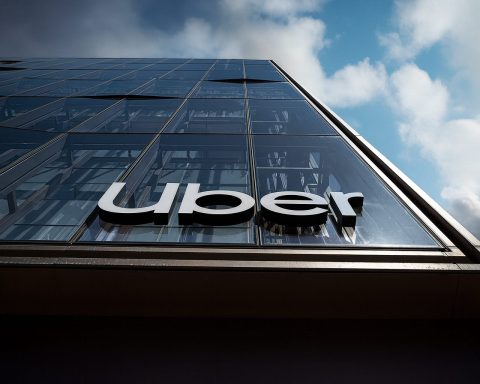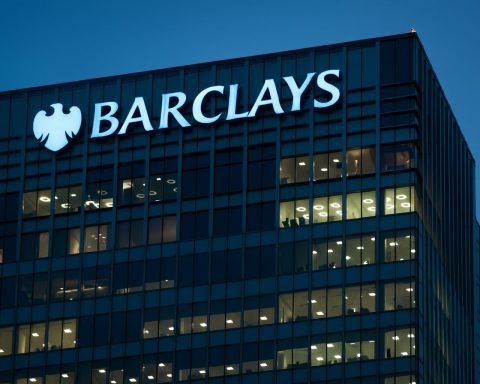- Stock Snapshot: PayPal (NASDAQ: PYPL) trades around $71 per share as of early October 2025, giving it a market cap near $68 billion. The stock’s P/E ratio is ~15 (trailing) [1], and it has climbed roughly 16% year-to-date, outpacing the S&P 500’s return [2]. Shares remain far below their mid-2021 peak, but are off 2022’s lows (52-week range ~$56–$94 [3]).
- Latest Price Move: PYPL spiked almost 5% in pre-market trading on Oct 7, 2025 after unveiling a new advertising platform for merchants [4]. The PayPal Ads Manager will let small businesses create retail media ads on their sites to generate new revenue streams, leveraging PayPal’s vast transaction data [5] [6].
- Recent Earnings Beat: PayPal’s Q2 2025 earnings topped expectations with EPS $1.40 (vs $1.30 consensus) and $8.29 B revenue, continuing a streak of earnings beats [7] [8]. The company raised its FY2025 profit guidance to $5.15–$5.30 EPS (above prior $4.95–$5.10 and the Street’s $5.10 estimate) [9]. Q3 2025 results are due Oct 28, 2025 [10].
- Analyst Outlook: The median analyst 12-month price target is in the mid-$80s (~20–25% upside) [11] [12]. However, sentiment is mixed – Wolfe Research downgraded PYPL on Oct 3 citing uncertainty in re-accelerating core growth [13], even as it praised PayPal’s cost cuts and new product initiatives [14]. Overall Wall Street consensus is Hold, with ~17 Buys, 15 Holds, 2 Sells [15].
- Fintech Industry Trends: PayPal faces fierce competition (e.g. Block/Square, Stripe, Apple Pay) but sits in a booming digital payments market forecast to grow ~17% CAGR through 2030 [16] [17]. The company is expanding beyond payments – into AI-powered shopping tools [18], Buy Now Pay Later (BNPL) services, and now advertising – to capture new growth. Investors are watching how these moves and a more profit-focused strategy under new CEO Alex Chriss position PayPal amid a fintech resurgence in 2025.
Stock Performance and Current Trading Metrics
PayPal’s stock has seen a modest rebound in 2025 amid improving fintech sentiment. At about $71–$74 in early October, PYPL has gained roughly 15–17% year-to-date [19], slightly outperforming the S&P 500. The stock’s market capitalization stands near $68 billion, with a P/E ratio around 15 based on trailing earnings [20]. By comparison, the S&P 500’s forward P/E is in the high-teens, indicating PayPal is valued at a discount to the market despite its solid profitability. Volume has averaged ~17 million shares per day, reflecting active investor trading interest (especially around news events). Key technicals show the stock hovering near its 50- and 200-day moving averages(both in the high-$60s) [21], suggesting a consolidating trend.
Longer-term, PYPL is still well below its all-time high (~$310 in 2021), after a steep 2022–2023 slide that erased pandemic-era gains [22] [23]. That downturn reflected slowing growth post-COVID and rising competition. However, over the past year PayPal has stabilized: it’s up from 2022 lows (~$55) and has outpaced many fintech peers. For context, PayPal’s 52-week range is approximately $55.85 – $93.66 [24], so the current price sits in the lower half of that range. The beta ~1.4 indicates above-market volatility [25] – not surprising given the stock’s swings on both market-wide tech rallies and company-specific news.
Investors appear cautiously optimistic. Institutional ownership remains strong at over 68% of shares [26], suggesting confidence from major funds. At the same time, options markets and social media show mixed sentiment – some traders view PYPL as a value play given its low earnings multiple, while others remain wary until growth reaccelerates. Overall, PayPal’s stock performance in 2025 reflects a balance of improved execution and earnings(driving recent outperformance) against lingering concerns from its prior slump.
Recent News and Developments (Early October 2025)
PayPal has made headlines in early October 2025 with new product launches and strategic moves:
- Advertising Platform Launch: On October 7, PayPal announced PayPal Ads Manager, a new service that allows the “tens of millions” of small businesses on PayPal to run their own ads and earn extra revenue [27]. This retail media tool lets merchants easily place ads on their sites via a PayPal-provided SDK, with proceeds deposited to their PayPal accounts [28]. The platform, rolling out in early 2026 (U.S. first, then UK and Germany), aims to “democratize” retail media, a fast-growing ad segment long dominated by giants like Amazon. PayPal stock jumped ~4–5% on the news [29], signaling investor enthusiasm for this diversification. “We’re enabling small businesses to participate in the same high-margin advertising model that’s powering growth at some of the largest companies in the world,” said PayPal Ads GM Mark Grether, highlighting how Ads Manager opens a lucrative channel previously “reserved for large enterprises” [30].
- Buy Now, Pay Later Boost: In a bid to drive holiday-season usage, PayPal unveiled a 5% cash back incentive for its BNPL service. Announced Oct 6, the promotion lets U.S. shoppers earn 5% back (up to $25) on PayPal Pay Later purchases for a limited time [31]. This move not only rewards users but also showcases PayPal’s commitment to BNPL, a space seeing rapid adoption. (BNPL volumes have been growing industry-wide, and PayPal reported its BNPL loan portfolio is expanding – backed by a recent deal to offload receivables to investment firm Blue Owl Capital [32] to manage credit risk). The 5% cashback promo positions PayPal competitively against BNPL-focused players like Affirm and Klarna during the key holiday period [33].
- Global Partnerships: PayPal is extending its reach through partnerships. Notably, it partnered with India’s NPCI(National Payments Corp.) to integrate India’s UPI (Unified Payments Interface) into PayPal’s platform. CEO Alex Chriss announced at a fintech event in Mumbai that UPI is the first payments system to be onboarded on “PayPal World,” an international payments hub [34]. This tie-up means Indian consumers and small exporters could more seamlessly make cross-border transactions via PayPal using UPI – a significant step, as UPI is used by hundreds of millions in India. PayPal also recently struck a multi-year partnership with DP World(a global logistics provider) to improve cross-border digital trade payments [35], and a strategic collaboration with Google to integrate PayPal’s payments into Google’s AI-driven commerce initiatives [36]. These alliances indicate PayPal’s focus on growing its international and cross-platform presence.
- Executive Moves: In leadership news beyond PayPal’s walls, former CEO Dan Schulman (who led PayPal from 2015 until stepping down in 2023) made headlines on Oct 6 by being named the new CEO of Verizon Communications [37]. Verizon’s surprise appointment of Schulman underscores the reputation PayPal’s leaders have in the broader tech and finance world. (It also temporarily put PayPal in the spotlight: Verizon’s stock popped on the news, and commentators noted Schulman’s fintech expertise could help the telecom giant [38].) Within PayPal, Alex Chriss – a former Intuit executive – has now been CEO for about a year, steering a strategy shift (as discussed below) toward efficiency and new revenue streams. There’s no indication of major PayPal management changes in October, but Schulman’s high-profile move is a reminder of the company’s influence in the industry.
Overall, PayPal’s recent news cycle portrays a company actively evolving – launching new products (Ads, BNPL incentives), expanding partnerships globally, and benefitting from a generally positive market environment for tech. These developments in the first week of October have been received well by investors, with PYPL’s stock gaining on product news and showing resilience amid market volatility.
Earnings and Financials: Steady Growth, Profit Focus
PayPal’s financial picture in 2025 has been marked by solid earnings beats and a pivot to profitable growth. In the second quarter of 2025, PayPal delivered better-than-expected results: adjusted EPS of $1.40 (topping estimates by $0.10) on $8.29 billion revenue [39]. Revenue grew about 3% year-over-year (slightly slower than previous quarters, partly due to currency headwinds and e-commerce normalization), but cost discipline boosted margins. Notably, Venmo’s growth accelerated to a 3-year high in Q2 as PayPal monetizes that platform more effectively [40].
On the earnings call, management struck a confident tone about controlling expenses and driving high-margin initiatives. They raised the full-year 2025 earnings forecast to $5.15–$5.30 EPS, up from a prior $4.95–$5.10 [41]. This new guidance was above analyst consensus at the time [42], signaling optimism about the rest of 2025. PayPal’s CFO noted the guidance even leaves “room to absorb” a bit of macroeconomic softness if consumer spending slows [43]. Indeed, transaction margins have improved as the company pulls back from low-margin areas and focuses on its most profitable services.
Despite the strong Q2 beat and higher outlook, investors reacted coolly initially – PayPal’s stock fell ~8% after the Q2 report on concerns about slowing growth in its core “branded” payments business [44]. Branded total payment volume (TPV) – essentially transactions where PayPal is used as a checkout option – grew only ~5% in Q2, a comedown from mid-single-digit growth previously [45]. This flat year-over-year branded volume raised eyebrows, since it hints that competition (and possibly changing consumer habits) are weighing on PayPal’s flagship checkout buttons. PayPal attributed some of the softness to macro factors – e.g. U.S. shoppers cutting back on discretionary buys amid new tariffs and inflation worries [46]. Still, this dynamic underscored why PayPal is diversifying (into areas like unbranded processing via Braintree, and new products like the Ads service).
Upcoming Earnings: All eyes are now on PayPal’s Q3 2025 earnings release, slated for October 28, 2025 [47]. Analysts will be looking for confirmation that PayPal can hit the higher end of its guidance. For Q3, the company’s own guidance is $1.18–$1.22 in EPS [48] (which would be roughly 20% growth year-on-year) and continued mid-single-digit revenue growth. Key metrics to watch include total payment volume (TPV)growth, especially branded TPV vs. unbranded (Braintree) volumes, active user trends, and take rate (revenue as a % of payment volume). Investors will also scrutinize margin improvements – PayPal has promised to grow operating expenses at less than half the rate of gross profit growth [49], reflecting stringent cost control under the new CEO.
Financially, PayPal remains a cash-generating machine. It produced over $5.5B in net income in 2023 [50] and has a strong balance sheet (debt-to-equity ~0.56 [51], with ample liquidity). The company has been returning cash to shareholders via stock buybacks rather than dividends (no dividend is paid). In 2025, PayPal continued repurchasing shares, which helped boost its EPS. Free cash flow is robust (TTM FCF around $6.7B, nearly double 5 years ago) [52], giving management flexibility to invest in new initiatives (AI, crypto, acquisitions) while still meeting profit targets.
Big picture: PayPal’s earnings trend shows a shift from high-growth mode to a balanced growth and profit mode. The market will reward PayPal if it can demonstrate sustainable mid-digit revenue increases with double-digit EPS growthvia margin expansion. The raised 2025 profit outlook indicates confidence on that front. But any stumble in user growth or payment volume (especially if competitors are taking share) could weigh on the stock. Thus, the Q3 report and holiday-quarter commentary will be crucial in validating PayPal’s trajectory into 2026.
Forecasts and Outlook
Looking ahead, forecasts for PayPal remain cautiously optimistic. Sell-side analysts currently have a consensus 12-month price target around $84–$85 per share [53], implying roughly 20% upside from current levels. For instance, 24/7 Wall St. projects PYPL could reach $81+ by the end of 2025 (~20% upside) based on earnings estimates and a P/E ~16 [54]. The median target of ~$84 reflects expectations that PayPal’s stock will appreciate as the company delivers on its earnings growth plan. However, that consensus target has come down over the past year (it was well over $100 a year ago), mirroring tempered growth assumptions.
On the earnings front, Wall Street expects PayPal to post around $5.03 EPS for full-year 2025 (per FactSet/LSEG aggregations) [55], which is actually slightly below PayPal’s own guidance midpoint – suggesting analysts are a bit conservative. Going into 2026, forecasts call for low double-digit EPS growth as cost efficiencies continue and revenue accelerates modestly. PayPal’s long-term target (as of its last investor day) is for 15%+ EPS growth and 10%+ revenue growth annually, though hitting that will likely require an economic tailwind or new revenue streams scaling up.
Some key factors shaping the outlook:
- Consumer Spending & Macro: PayPal’s transaction volumes are sensitive to overall e-commerce trends. The good news is U.S. consumer spending has been resilient in 2025, and inflation is receding. If a soft landing for the economy plays out (or interest rates start to ease), online spending could tick up, lifting PayPal’s volumes. Conversely, any downturn or renewed inflation could crimp discretionary online sales. PayPal built some macro caution into its guidance (as CFO Gabrielle Rabinovitch noted, they allowed for a “couple points of deceleration in e-commerce spending” just in case [56]). Many analysts see 2025 holiday sales as a pivotal gauge – a strong Q4 could buoy forecasts for 2026.
- Competitive Positioning: PayPal still commands a leading position in digital payments, but competitors are encroaching (more on that in the Trends section). The outlook assumes PayPal will at least maintain its share in checkout and peer-to-peer payments. Newer initiatives like tapping Venmo for in-store payments, expanding merchant services, and international growth (e.g. in emerging markets) could add upside. Conversely, if PayPal’s branded checkout continues to stall or if rivals like Apple Pay accelerate faster, analysts may cut forecasts. So far, most expect mid-single-digit volume growth to continue, with upside if PayPal’s innovations (like the Honey AI shopping tool or Ads Manager) start contributing materially by 2026.
- Profit Margins: A core part of PayPal’s future is margin expansion. Under CEO Alex Chriss, PayPal is focusing on efficiency – aiming to grow opex at half the rate of gross profit growth [57]. In practical terms, this means even modest revenue upticks should translate into double-digit profit gains. Analysts generally believe PayPal can achieve mid-20s % operating margins, given its scale, which bodes well for EPS. Indeed, at a P/E ~15, the market is not pricing in much growth – if PayPal can consistently hit high-teens EPS growth, multiples could expand. Some bulls argue PYPL deserves a higher valuation given fintech peers often trade at 20+ P/E.
- Fintech Sector Valuation: Broader sentiment toward fintech stocks has improved entering 2025, after a harsh 2022–23. Fintech is seen as an area of renewed growth (some even call 2025 a potential “fintech comeback” year [58]). If that theme plays out, investors could rotate back into quality fintech names like PayPal, lifting its stock. Already, PayPal’s year-to-date climb suggests the worst of the pessimism has passed. On the flip side, any shock (like a major regulatory move or fintech-unfriendly legislation) could cap the upside. For now, many experts, including those at Global X ETFs, see “several converging secular trends point to a favorable outlook for 2025” in fintech, from strong consumer spending to product innovations in AI/crypto [59]. PayPal is positioned to benefit from those tailwinds.
In summary, the forecast for PayPal is one of moderate growth and incremental improvement. Price targets in the $80s reflect an expectation of execution on cost cuts and new revenue streams. While few expect a return to hyper-growth in the near term, there is a sense that PayPal has turned a corner financially. As long as the company hits its earnings marks and shows progress in reigniting its core payments engine, the stock has room to run. Conversely, any guidance miss or evidence that competition is eroding PayPal’s user base could quickly sour sentiment again. Thus, the next couple of earnings reports (Q3 and Q4 2025) are essentially “prove it” moments for PayPal’s outlook.
Analyst and Expert Commentary
Wall Street analysts are divided but generally hopeful that PayPal’s strategic shift will pay off, even as some urge caution. A recent note from Wolfe Research encapsulates the mixed sentiment: Wolfe downgraded PYPL to “Peer Perform” (hold) on Oct 3, 2025, citing lingering “questions about PayPal’s ability to accelerate branded [checkout] growth” – a key driver for market share and profit [60]. Wolfe’s analysts worry that without a clear rebound in its core branded payments business, PayPal’s stock may “remain rangebound” until the company proves it can re-ignite sustainable growth [61]. Essentially, even though PayPal is cutting costs and expanding into new areas, the traditional PayPal button needs to regain momentum to really impress the market.
At the same time, Wolfe’s note acknowledged a lot of positives: “PayPal has made progress streamlining operations and returning capital to shareholders under its new management team,” the analysts wrote, lauding steps like expense management, improving Braintree (unbranded processing) margins, better monetization of Venmo, and momentum in PayPal’s debit card business [62]. They even noted PayPal boasts a “perfect Piotroski Score of 9” (a sign of strong financial health) and a modest valuation [63]. Wolfe set a fair value of ~$70–$80 for year-end 2026, indicating they see the stock as roughly fairly valued at present [64]. In summary, their stance is: good execution so far, but show us faster growth.
Other analysts echo the theme of cautious optimism. Back in late July, after Q2 earnings, RBC Capital Markets analysts pointed out that “investors’ near-term sensitivity to branded TPV growth” could temper enthusiasm over PayPal’s good results [65]. RBC noted that PayPal’s commentary about slight softening in consumer spending (and the slow branded growth) made some investors nervous [66]. However, RBC and others were encouraged by the profit forecast hike and signs that “PayPal’s push to revive growth in high-margin businesses, led by Venmo, has begun to pay off” [67]. In other words, analysts see the company doing the right things – focusing on Venmo, new products, and profitability – but the proof will be in re-accelerating overall volume.
The consensus rating on PYPL is essentially Hold/Moderate Buy. Out of ~34 analysts tracked, about half rate it a Buy and half Hold, with only a couple Sells [68]. This split reflects uncertainty: PayPal is a fundamentally solid, highly profitable franchise, but its growth rate is in question. “Wall Street may be undervaluing this giant,” one MarketBeat analyst wrote, arguing that investor skepticism has gone too far and that PayPal’s large user base and earnings power aren’t fully appreciated [69] [70]. Bulls often highlight that PayPal is trading at a historically low multiple for a fintech leader and that any uptick in growth (or simply continued buybacks) could drive the stock higher.
Expert opinions in the media also emphasize industry context. Yahoo Finance recently discussed how PayPal is evolving beyond a payments app into a broader commerce platform. The company’s introduction of AI-driven shopping tools in its Honey subsidiary in September was cited as an example of “shifting the investment narrative” for PayPal [71]. By embedding real-time product recommendations and offers into AI chatbots, PayPal signaled it’s leveraging artificial intelligence to deepen user engagement in commerce, not just payments. This kind of innovation is seen as critical for PayPal to shake off its image as a “stagnant” payments utility and instead be viewed as a fintech innovator. Analysts have noted that if these moves (AI in Honey, the Ads Manager, crypto initiatives, etc.) gain traction, they could open new revenue streams and re-energize investor interest.
From an investor sentiment standpoint, PayPal has been a hot topic on fintech forums. Sentiment turned notably bearish in 2022 when the stock was plunging, but in 2025 discussions have become more balanced. Some point to PayPal’s giant active user base (~431 million accounts) and say the network effects give it resilience – a competitive moat that newcomers will struggle to crack. Others counter that younger consumers prefer newer payment apps (Cash App, Zelle, etc.), and that PayPal must modernize its brand and UX to stay relevant. The company’s efforts with Venmo (integrating it into Amazon checkouts, for example) and its embrace of crypto (remember, PayPal launched its own stablecoin PYUSDin 2023) are often brought up as signs it’s adapting. Yet, critics on social media note that those initiatives haven’t meaningfully moved the needle on growth yet. The upcoming quarters could change that narrative if, say, PayPal’s crypto trading volumes or BNPL usage spike upward, giving a new story for bulls to tell.
In financial media, there’s also talk of whether PayPal could be a takeover target at its reduced valuation – though with a $68B market cap, only the largest tech or payment companies could even contemplate that, and there’s no concrete evidence of any bids. More realistically, some activist investors might push for further changes if the stock stagnates (PayPal saw activist involvement from Elliott Management in 2022, which led to cost cuts and a shakeup). So far in 2025, there’s no public activist campaign, likely because PayPal is already executing a lot of the playbook (cost cuts, buybacks, new CEO, etc.) that an activist would demand.
Bottom line from analysts and experts: PayPal is getting credit for its improved execution and strategic pivots, but many are in “wait and see” mode regarding a true growth revival. As a Reuters analysis phrased it, PayPal has “shifted its focus to profitability rather than chasing top-line growth” under CEO Chriss [72], which is boosting earnings – yet to really excite Wall Street again, PayPal “must show it can regain momentum” in areas that “lost steam after the pandemic-era boom faded” [73]. If PayPal’s upcoming results demonstrate that momentum (for example, accelerating payment volumes, success in new ventures like Ads or crypto), expect analysts to turn more uniformly bullish. Until then, the commentary will likely remain mixed, albeit with a positive tilt given the franchise’s strength.
Fintech and Digital Payments Industry Trends
PayPal operates in a rapidly evolving fintech and digital payments landscape, and understanding the broader trends is key to assessing its future:
- Payment Volume Explosion: Digital payments worldwide continue to grow at an exponential rate. Global transaction value via payment service providers (PSPs) has jumped from about $6.3 trillion in 2017 to over $15 trillion in 2023, and is forecast to reach a staggering $36+ trillion by 2029 [74] [75]. This rising tide lifts established players like PayPal – there’s a lot more volume to capture. PayPal’s network (over 200 markets and 25+ currencies supported) positions it to benefit as more commerce goes cashless and online. In the U.S., e-commerce and digital wallet usage is still growing steadily, supported by strong consumer spending and a robust job market in 2025 [76] [77]. Notably, small businesses’ sales and transactions have been rising mid-single digits year-over-year, indicating healthy underlying payment demand [78]. This trend bodes well for PayPal’s merchant services and volume growth if it can maintain its share of transactions.
- Post-Pandemic Competition: The flip side of that growth is intense competition. PayPal’s dominance in online checkout has been challenged by the likes of Apple Pay, Google Pay, Amazon Pay, Stripe, Shopify Payments, and others. Big retailers have launched their own payment solutions too. PayPal’s share of e-commerce checkout has slipped from its peak, prompting the company to diversify (e.g., focusing on Braintree for unbranded processing, where it powers payments behind the scenes for many online merchants, and expanding Venmo). Traditional banks and card networks are also innovating (e.g., Visa and Mastercard with one-click payment initiatives) to reduce friction, directly encroaching on PayPal’s territory. In point-of-sale and peer-to-peer payments, Block (Square/Cash App) and others have strong traction among younger users. A 24/7 Wall St. analysis noted that after the pandemic boom, “increased competition… forced PayPal to diversify its business” to defend its turf [79]. This is evident in PayPal’s push into areas like crypto and buy-now-pay-later – it’s seeking new edges as pure online payments become a more crowded field.
- Buy Now, Pay Later & Credit: One of the hottest segments in fintech has been BNPL, and PayPal is a major player. Its Pay in 4 offering has millions of users, and the company reported over $20 billion in BNPL payment volume in 2022. The BNPL industry is forecast to grow at 24% CAGR through 2030 [80], outpacing overall payments, as consumers (especially Gen Z and Millennials) embrace installment payments for purchases. PayPal is leveraging this trend – it already has scale (larger user base than pure-plays like Affirm), and it recently committed $$100 million to invest in fintech startups in regions like the Middle East/North Africa [81], possibly to expand offerings. However, BNPL growth comes with caveats: credit risks and rising regulatory scrutiny. PayPal’s approach has been relatively conservative (short-term installments, often zero interest to the user, merchant-funded fees). By selling a chunk of its BNPL loan receivables to third parties (like the new Blue Owl Capital partnership [82]), PayPal limits credit exposure while still earning fees. In sum, BNPL is both a growth avenue and a competitive space – PayPal must innovate (as it did with the 5% cashback promo) to stay ahead of Affirm, Klarna, Afterpay, and others.
- Crypto and Digital Currencies: Fintech and crypto are increasingly intertwined. PayPal has been at the forefront among mainstream fintechs in embracing crypto – it enables users to buy/sell Bitcoin, Ethereum, and more in its app, and as mentioned, even launched its own stablecoin (PYUSD) in 2023 to facilitate crypto-based payments. Industry-wide, 2025 has seen a resurgence in crypto interest (Bitcoin hit new highs around $125k in late 2024 [83]). PayPal’s strategy appears to integrate crypto where it makes sense: for example, allowing checkout with crypto (converting to fiat for merchants) and potentially using blockchain tech for faster settlements. A Bloomberg piece on 2025 fintech themes noted “crypto payments are expected to go mainstream,” given a more crypto-friendly U.S. regulatory stance and companies like PayPal and Stripe investing in the space [84]. If crypto adoption continues, PayPal could stand to gain by being an early mover – or at least avoid disintermediation by crypto alternatives. However, this is still a nascent area for revenue (crypto fees are a tiny portion of PayPal’s sales today).
- Artificial Intelligence and Personalization: Another big trend is AI integration. Fintech firms are using AI for everything from fraud detection to customer service chatbots to personalized financial advice. PayPal is no exception. It highlighted using AI to combat fraud/scams (a perpetual challenge in payments) in recent updates [85]. More visibly, PayPal is infusing AI into consumer products: its Honey unit’s new shopping recommendations via chatbot is one example [86]. Also, the new Ads Manager likely will leverage AI for ad targeting and possibly for helping small businesses create ad content (the press release mentioned “AI-powered creative tools” for easy ad generation [87]). The broader point: AI can enhance PayPal’s value proposition by making payments “smarter” – e.g., anticipating what offers a user might want, or detecting suspicious activity in real time. The fintechs that successfully harness AI could drive higher user engagement and lower operating costs. PayPal appears to be investing accordingly, and it even partnered with Google to tap Google’s AI expertise in commerce solutions [88]. This trend is still in early innings, but it’s a key one to watch in 2025 and beyond.
- Regulation and Fees: Globally, digital payments face an evolving regulatory environment. In some regions, regulators are pushing for lower transaction fees or more competition (for instance, the EU’s caps on interchange fees, or India’s promotion of UPI as a low-cost alternative). PayPal must navigate these. Notably, PayPal recently called global regulatory complexity a challenge – CEO Chriss commented that differing rules make scaling fintech globally tricky, even as PayPal partners with systems like UPI [89]. In the U.S., there’s been discussion about open banking rules which could affect how fintechs access bank data (JPMorgan even said fintechs might have to start “paying for customer data” from banks [90]). Such shifts could impact PayPal’s costs or its data-driven services. So far, there haven’t been any major adverse regulatory hits to PayPal in 2025, but it’s an area to monitor, especially as politicians eye big tech and payments fees.
In summary, the fintech and digital payments sector in 2025 is marked by strong growth prospects and rapid innovation, with PayPal actively engaged on multiple fronts. The company is benefiting from the secular shift to cashless commerce and is trying to set the pace (or at least keep up) in emerging areas like BNPL, crypto, and AI-enhanced finance. Investor enthusiasm for fintech has rekindled, as noted by Global X, thanks to factors like improving profitability and new tech integrations across the industry [91] [92]. PayPal’s challenge and opportunity is to leverage its scale and trust to ride those waves, all while fending off agile upstarts and deep-pocketed competitors. The next chapter of the fintech revolution will likely see winners defined by who can offer the most seamless, value-rich ecosystem – and PayPal is clearly aiming to be among them, evolving from a simple payment button into a broad digital financial platform.
Conclusion
As of October 7, 2025, PayPal Holdings Inc. finds itself at a pivotal moment. The company is doubling down on new ventures – from advertising to AI-driven shopping tools – in a bid to reignite growth, even as it continues to deliver reliable earnings and improved margins. The stock has perked up from last year’s doldrums, but remains a show-me story: investors are looking for evidence that PayPal can reclaim its fintech leadership in a rapidly changing market.
The latest developments, like the PayPal Ads Manager launch, have injected some excitement and suggest management isn’t standing still. Coupled with a renewed focus on efficiency under CEO Alex Chriss, PayPal is steering into 2026 with a leaner operation and broader ambitions than just online checkout. Financially, the firm is on solid ground – beating estimates and raising forecasts – which gives it the breathing room to innovate.
Will PYPL stock break out of its range? Much depends on execution in the coming quarters. If PayPal can translate industry tailwinds (cashless payments growth, fintech’s renaissance) into accelerating user engagement and volume – all while maintaining strong profit growth – analysts and investors could warm up to this one-time Wall Street darling again. The consensus seems to be that PayPal’s downside is limited by its core strengths (massive user base, trusted brand, consistent profits), but the upside will be determined by its success in writing a new playbook for growth in the post-pandemic fintech era.
For now, PayPal offers a compelling mix of value and potential. It’s a profitable incumbent trading at a relatively low multiple, yet it’s plugged into some of the most exciting trends in finance and tech. The coming months – with an earnings release on deck and holiday season dynamics – should provide crucial signals. Investors are watching closely to see if PayPal’s big bets start to pay off, and whether 2025 marks the beginning of a true comeback for PYPL in the eyes of the market.
Sources: Key information and quotes in this report were drawn from recent financial news and analysis, including Reuters [93] [94], Yahoo Finance [95], Investing.com [96], PR Newswire releases [97], MarketBeat [98], Zacks and 24/7 Wall St. [99], as well as industry commentary from Global X and others [100] [101]. These sources provide a comprehensive view of PayPal’s current performance, market sentiment, and the broader trends shaping its strategy.
References
1. www.marketbeat.com, 2. finance.yahoo.com, 3. www.marketbeat.com, 4. www.investing.com, 5. www.investing.com, 6. www.investing.com, 7. www.marketbeat.com, 8. www.marketbeat.com, 9. www.reuters.com, 10. finance.yahoo.com, 11. 247wallst.com, 12. www.marketbeat.com, 13. www.investing.com, 14. www.investing.com, 15. www.marketbeat.com, 16. 247wallst.com, 17. 247wallst.com, 18. swingtradebot.com, 19. finance.yahoo.com, 20. www.marketbeat.com, 21. www.marketbeat.com, 22. 247wallst.com, 23. 247wallst.com, 24. www.marketbeat.com, 25. www.marketbeat.com, 26. www.marketbeat.com, 27. www.investing.com, 28. www.investing.com, 29. www.investing.com, 30. finviz.com, 31. www.prnewswire.com, 32. www.marketscreener.com, 33. www.digitaltransactions.net, 34. economictimes.indiatimes.com, 35. www.marketscreener.com, 36. www.investing.com, 37. finance.yahoo.com, 38. finance.yahoo.com, 39. www.marketbeat.com, 40. www.reuters.com, 41. www.reuters.com, 42. www.reuters.com, 43. www.reuters.com, 44. www.reuters.com, 45. www.reuters.com, 46. www.reuters.com, 47. finance.yahoo.com, 48. www.marketbeat.com, 49. www.investing.com, 50. 247wallst.com, 51. www.marketbeat.com, 52. 247wallst.com, 53. www.marketbeat.com, 54. 247wallst.com, 55. www.marketbeat.com, 56. www.reuters.com, 57. www.investing.com, 58. globalxetfs.co, 59. globalxetfs.co, 60. www.investing.com, 61. www.investing.com, 62. www.investing.com, 63. www.investing.com, 64. www.investing.com, 65. www.reuters.com, 66. www.reuters.com, 67. www.reuters.com, 68. www.marketbeat.com, 69. www.marketbeat.com, 70. www.marketbeat.com, 71. swingtradebot.com, 72. www.reuters.com, 73. www.reuters.com, 74. 247wallst.com, 75. 247wallst.com, 76. globalxetfs.co, 77. globalxetfs.co, 78. globalxetfs.co, 79. 247wallst.com, 80. 247wallst.com, 81. www.investing.com, 82. www.marketscreener.com, 83. ts2.tech, 84. www.bloomberg.com, 85. newsroom.paypal-corp.com, 86. swingtradebot.com, 87. finviz.com, 88. www.investing.com, 89. m.economictimes.com, 90. www.bloomberg.com, 91. globalxetfs.co, 92. globalxetfs.co, 93. www.reuters.com, 94. www.investing.com, 95. swingtradebot.com, 96. www.investing.com, 97. finviz.com, 98. www.marketbeat.com, 99. 247wallst.com, 100. globalxetfs.co, 101. 247wallst.com
